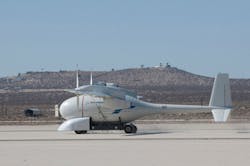ST. LOUIS, 8 Feb. 2013. Boeing's [NYSE: BA] liquid hydrogen-powered Phantom Eye unmanned aerial vehicle (UAV) has completed taxi testing at Edwards Air Force Base in California as it progresses toward its second flight. During the testing, which occurred Feb. 6, the Phantom Eye demonstrator aircraft sitting atop its launch cart reached speeds up to 40 knots, or approximately 46 miles per hour. The Phantom Eye team has also completed software and hardware upgrades to prepare for flying at higher altitudes.
| Related stories -- Boeing Phantom Eye UAV completes first autonomous flight, sustains damage on landing -- Boeing unveils Phantom Eye demonstrator UAV -- The future of UAV technology aims high |
Additionally, the team improved the aircraft’s landing system following Phantom Eye's first flight, when the landing gear dug into the Edwards lakebed and broke. The improved landing system is based off Boeing's fighter aircraft systems.
Phantom Eye's liquid-hydrogen propulsion system will allow the aircraft to stay on station for up to four days while providing persistent monitoring over large areas at a ceiling of up to 65,000 feet, creating only water as a byproduct. The demonstrator, which features a 150-foot wingspan, is capable of carrying a 450-pound payload. Its first flight, in coordination with NASA's Dryden Flight Research Center at Edwards, was in June 2012.
Voice your opinion!
Voice your opinion!

